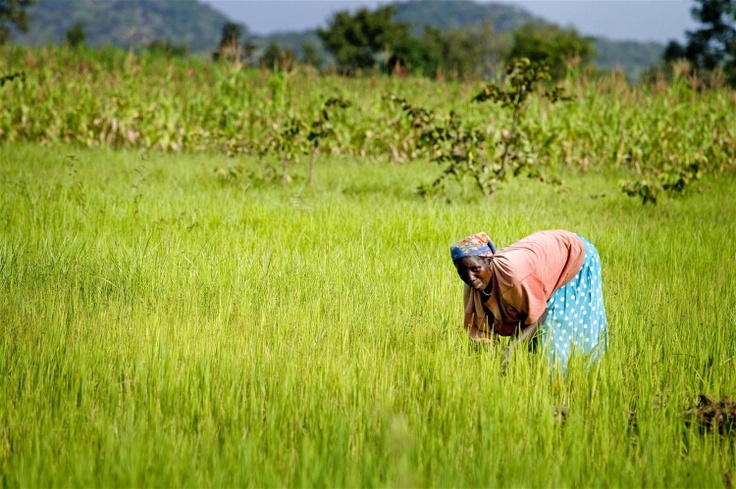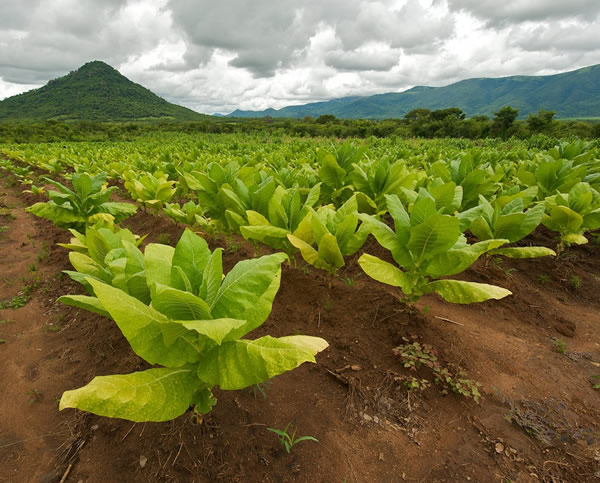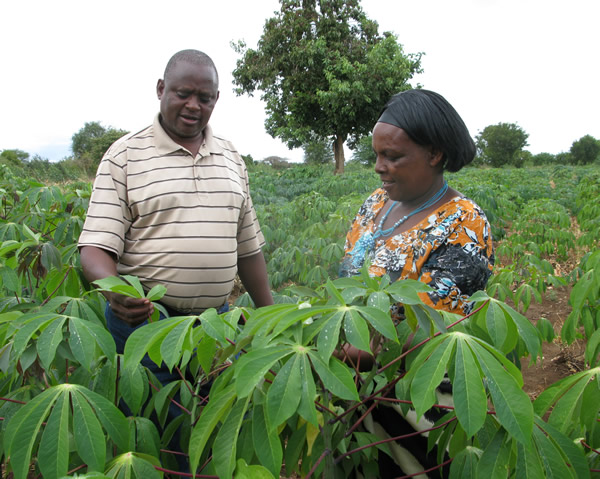 |
| Rice field in Africa |
Soil and climatic conditions throughout Africa determine not only agricultural practices, such as which crops can be grown, but also whether plant life is capable of sustaining livestock on the land and enabling fishing of the oceans.
Rainfall—the dominant influence on agricultural output—varies greatly among Africa’s fifty-six countries. Without irrigation, agriculture requires a reliable annual rainfall of more than 30 inches (75 centimeters). Portions of Africa have serious problems from lack of rainfall, such as increasing desertification and periods of drought.
Food output has declined, with per capita food production 10 percent less in the 1990’s than it was in the 1980’s. In most African countries, however, more than 50 percent, and often 80 percent, of the population works in agriculture, mostly subsistence agriculture. Large portions of the continent, such as Mali and the Sudan, have the potential of becoming granaries to much of the continent and producing considerable food exports.
  |
Traditional African Agriculture
Traditionally, agriculture in Africa has been subsistence farming in small plots. It has been labor-intensive, relying upon family members. New land for farming was obtained by the slash-and-burn method (shifting cultivation). The trees in a forested area would be cut down and burned where they fell.
The ashes from the burned trees fertilized the soil. Both men and women worked at such farming. Slash-and-burn agriculture is common not only in Africa but also in tropical areas around the world. In areas of heavy rainfall, the rains wash out the nutrients from soil and burned trees in a period of two to three years.
The crops grown depend upon the region. In the very dry, yet habitable, parts of Africa—such as the Sudano-Sahelian region that stretches from Senegal and Mali in the west of Africa to the Sudan in the east—a key subsistence crop is green millet, a grain. Ground into a type of flour, it can be made into a bread-like substance.
In moister areas, traditional crops are root and tuber crops, such as yams and cassava. Cassava has an outer surface or skin that is poisonous, but it can be treated to remove the poison. The tuber then can be ground and used tomake a bread-like substance.Other important traditional crops are rice and corn, which were introduced by Europeans when they came to Africa.
Animal husbandry, or seminomadic herding, is another form of traditional agriculture. Problems that have arisen with this type of agriculture are the availability of water and grass or hay for cattle. Regions that are very moist, such as the Gulf of Guinea, which has rain forest, are not good for cattle because of the tsetse fly, which carries diseases such as sleeping sickness.
Crops
 |
| African Agriculture |
The most widely grown crop is rice, which is grown on more than one-third of the irrigated crop area in Africa. Cultivated mostly in wetlands and valley bottoms, rice is the most common crop in the humid areas of the Gulf of Guinea and Eastern Africa. It is also grown on the plateaus of Madagascar.
In the northern and southern regions, rice represents only a small portion of the total crops under water management. Wheat and corn are cultivated and irrigated, mostly in Egypt, Morocco, South Africa, Sudan, and Somalia.
Vegetables, including root and tuber crops, are present in all regions and almost every country. Vegetables are grown on about 8 percent of the cultivated areas under water management. In Algeria, Mauritania, Kenya, Burundi, and Rwanda, they are the most widespread crops under water management.
Arboriculture (growing of fruit trees), which represents 5 percent of the total irrigated crops, is concentrated in the northern region and consists mostly of citrus fruits. Commercial crops (for cash and export) are grown mostly in the Sudan and in the countries of the southern region and consist mostly of cotton and oilseeds.
Other commercial crops in Africa are sugarcane, coffee, cocoa, oil and date palm, bananas, tobacco, and cut flowers. Sugarcane is grown in all countries except in the northern region. The other commercial crops are concentrated in a few countries.
North Africa
In Morocco, Algeria, Tunisia, Libya, and Egypt, the region’s agricultural resources are limited by its dry climate. Its products are those typical of the Mediterranean, steppe, and desert regions: wheat, barley, olives, grapes, citrus fruits, some vegetables, dates, sheep, and goats.
Agriculture employs less than 20 percent of the working population in Libya and as much as 55 percent in Egypt. From about the middle of the twentieth century, North Africa’s production failed to keep pace with its population growth and remained susceptible to large annual fluctuations.
 |
| Olives market in Marocco |
Cropland occupies about 33 percent of Tunisia but less than 3 percent of Algeria, Egypt, and Libya. Some export crops, such as citrus fruits, tobacco, and cotton, have suffered from strong international competition.
The northern region is not a major contributor to the continent’s fish catch. Morocco, however, with its cool, plankton-rich Atlantic waters and access to the Mediterranean Sea, is one of the world’s largest fish producers.
Sudano-Sahelian Region
This region comprises Mauritania, the western Sahara, Senegal, Gambia, Mali, Burkina-Faso, Niger, Chad, and the Sudan. Because of the region’s extreme dryness, mostly subsistence farming and seminomadic herding are practiced. Millet is the primary crop.
In the late twentieth century, this region was devastated by long droughts that caused famine and starvation. Mali and the Sudan have the Niger and Nile Rivers flowing through them. These great rivers provide plenty of water for irrigation of fields.
During the rainy season in Mali—typically June through September—the Niger River widens into a great, extensive floodplain. This area is good for the growing of rice. Similarly, in the Sudan the Blue and White Niles meet at Khartoum to form the Nile River.
Gulf of Guinea
This region comprises Guinea-Bissau, Cape Verde, Guinea, Liberia, Sierra Leone, Côte d’Ivoire, Togo, Ghana, Benin, and Nigeria. With the exception of Nigeria, agriculture there is dominated by rice cultivation. The percentage of total land area that is under cultivation ranges from 60 percent in Liberia to just 9 percent in Sierra Leone.
The total cultivable area of Ghana is 39,000 square miles (100,000 square kilometers), or 42 percent of its total land area. Only 4.8 percent of the total land area was under cultivation at the end of the twentieth century. Much of the cultivation is subsistence farming of yams and other crops.
Ghana’s efforts in agriculture have been hampered by droughts. Additional problems are that organic matter has been leached out of the soils by heavy rainfall and that increasing deforestation has led to additional erosion. This is the situation in much of the Gulf of Guinea and the central regions.
About half of Nigeria’s available land is under cultivation. Increasing rainfall from the semiarid north to the tropically forested south allows for great crop diversity. Principal food crops are corn, millet, yams, sorghum, cassava, rice, potatoes, and vegetables.
Nigeria was the world’s fourth-largest exporter of cocoa beans in 1990-1991, accounting for about 7.1 percent of world trade in this commodity. However, Nigeria’s share of the world cocoa market has been substantially reduced because of aging trees, low prices, black pod disease, smuggling, and labor shortages.
Central Region
This region comprises the Central African Republic, Cameroon, Congo-Brazzaville, Congo-Kinshasa, Gabon, Equatorial Guinea, Burundi, Rwanda, and São Tomé and Príncipe. Cameroon has 14.7 million acres of arable land.
In 1997, 55,000 tons of rice were produced, but the country imported 124,000 tons in 1995. In the central region, the percentage of arable land ranges from 0.4 percent for the Congo-Brazzaville to 47 percent for Rwanda.
Cassava is harvested in Congo-Brazzaville, Congo-Kinshasa, Equatorial Guinea, and Gabon. Corn is harvested in Congo-Brazzaville, Congo-Kinshasa, and Burundi. In Rwanda, 17 percent of the harvested land is used to grow sweet potatoes. Agriculture is not important in the economy of São Tomé and Príncipe.
Eastern Region
 |
| Tobacco plantation |
This region comprises Eritrea, Djibouti, Ethiopia, Somalia, Kenya, Uganda, and Tanzania. Agriculture employs about 80 percent of the labor force in Uganda and Ethiopia. Approximately 2.5 million small farms dominate agriculture in both countries.
About 84 percent of Uganda’s land is suitable for agriculture—a high percentage compared to the majority of African countries, such as Ethiopia with only 12 percent. Food crops account for about 74 percent of agricultural production.
Only one-third is marketed; the rest is for home consumption. In four years out of five, the minimum needed rainfall may be expected in 78 percent of Uganda but in only 15 percent of Kenya. Somalia and Ethiopia receive almost none of the needed minimum.
Tanzania has almost four million farms. Traditional export crops include coffee, cotton, cashew nuts, tobacco, and tea. Major staple foods (corn, rice, and wheat) are exported in times of surplus.
Tanzania’s climatic growing conditions are favorable for the production of a wide range of fruits, vegetables, and flowers. Drought-resistant crops (sorghum, millet, and cassava) and other substaples such as onions, Irish potatoes, sweet potatoes, bananas, and plantains are also produced.
Areas that have 20-30 inches (50-75 centimeters) of rainfall per year rely on a mixture of agriculture and livestock herding. Regions with a smaller annual rainfall or a long dry season can support only drought-resistant crops such as sorghum, millet, and cassava. Over large areas of eastern Africa, rainfall is inadequate for crop cultivation.
The whole of Somalia and 70 percent of Kenya receive less than 20 inches (50 centimeters) of rain four years out of five. In these areas, the only feasible use of land is for raising livestock. Agriculture is not an important factor in the economies of Eritrea and Djibouti.
Southern Region
This region comprises Angola, Namibia, Zambia, Zimbabwe, Malawi, Mozambique, Botswana, Lesotho, Swaziland, and South Africa. The arable percentage of the total land area ranges from 14 percent in Malawi to just 1 percent in Namibia. With the exception of Mozambique, where cassava predominates, corn is the major crop in the countries in this region.
About 13 percent of South Africa’s land area can be used for crop production. Rainfall varies across the country, and varied climatic zones and terrains enable the production of almost any kind of crop.
The largest area of farmland is planted with corn, followed by wheat, then oats, sugarcane, and sunflowers. The nation is well known for the high quality of its fruits, such as apples and citrus.
Agriculture is the predominant economic activity in Zimbabwe, accounting for 40 percent of total export earnings—about 22 percent of the total economy—and employing more than 60 percent of the country’s labor force.
The main export crops are tobacco, cotton, and oilseeds. Zimbabwe is usually self-sufficient in food production. Its main food crops are corn, soybeans, oilseeds, fruits and vegetables, and sugar.
Mozambique’s agriculture has been badly hindered by civil war. However, the country has considerable potential for irrigation due to the Zambezi and Limpopo Rivers. The irrigation potential is estimated to be 7.5 million acres. In the 1990’s, only 110,000 acres were irrigated, growing rice, sugarcane, corn, and citrus.
Agriculture and livestock production employ about 62 percent of Botswana’s labor force. Most of the country has semidesert conditions with erratic rainfall and poor soil conditions, making it more suitable to grazing than to crop production. The principal food crops are sorghum and corn.
Namibia’s cultivated area is only 506,000 acres—only 0.8 percent of the cultivable area. Agriculture makes up approximately 10 percent of the economy but employs more than 80 percent of the population. The major irrigated crops are corn, wheat, and cotton.
Indian Ocean Islands
 |
| Cassava plantation |
This region comprises Madagascar, Mauritius, the Comoros, and the Seychelles. During the 1990’s an estimated 8.7 million people lived in the rural areas, 65 percent of whom lived at the subsistence level.
Only 5.2 percent of Madagascar’s total land area (7.4 million acres) was under cultivation. Of the total land area, 50.7 percent supported livestock production, while 16 percent (1.2 million acres) of the land under cultivation was irrigated.
Cassava, planted almost everywhere on the island, is grown as well as corn and sweet potatoes, with smaller quantities of cotton, bananas, and cloves. The fisheries sector, especially the export of shrimp, has been the most rapidly growing area of the agricultural economy in the Indian Ocean Islands region.
Mauritius has 30,000 acres of sugarcane plantations that have had one of the highest sugarcane and sugar yields in the world. The Seychelles have a total land area of only 72 squaremiles (187 square kilometers), of which only 3,000 acres are cultivated.
This 3 percent of the land area accounts for only 4 percent of the island nation’s economy. The Comoros’ agriculture is heavily weighted toward rice, the staple food of the populace.
